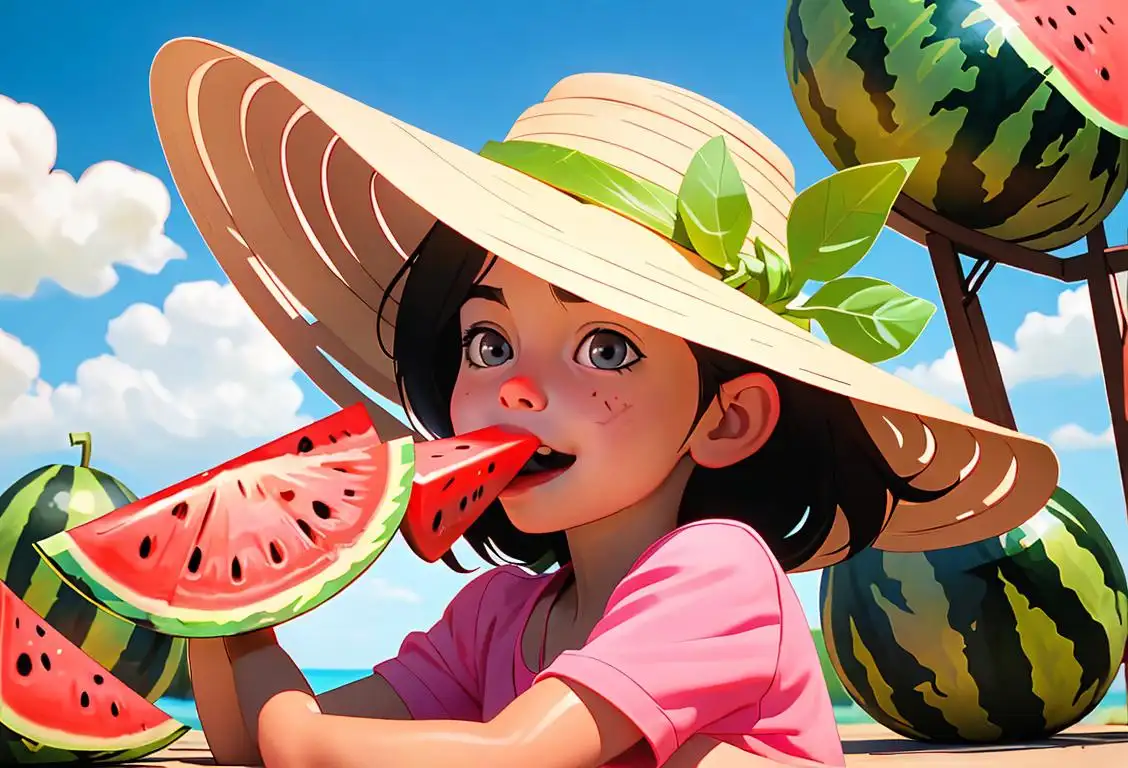National Water Melon Day

Welcome to WhatNationalDayIsIt.com, your friendly guide to all the quirky national days that make the Internet such a fun and whimsical place! Today, we're diving into the juicy world of watermelons as we celebrate National Watermelon Day. Get ready for some refreshing facts and mouth-watering goodness!
When is Water Melon Day?
It's national water melon day on the 3rd August.
Watermelon Wonderland
National Watermelon Day is a day dedicated to the summertime favorite that's as refreshing as a cool dip in the pool. This beloved fruit, with its vibrant green rind and sweet, juicy flesh, has been a staple at picnics, parties, and backyard barbecues for as long as we can remember. So sit back, relax, and let's explore the fascinating history of this melon marvel!
The Internet Goes Watermelon-Crazy
On August 3, 2015, the Internet exploded with excitement as watermelon enthusiasts from all corners of the web came together to celebrate National Watermelon Day. Memes, gifs, and videos featuring watermelon-themed humor flooded social media feeds, making it one of the most talked-about national days of that year.
Fun Watermelon Facts
Did you know that watermelons are not just delicious, but also incredibly healthy? They’re packed with vitamins A, B6, and C, as well as potassium and lycopene, which is beneficial for heart health. Plus, watermelons are approximately 92% water, making them a hydrating treat for hot summer days!
Watermelon Treats Galore
From fruity cocktails to refreshing salads, watermelons are an incredibly versatile fruit that can be enjoyed in countless ways. You can slice them up and share with loved ones, use them as a base for delicious sorbets, or even grill them for a unique twist on the traditional barbecue fare. The possibilities are as endless as the melon’s juicy goodness!
History behind the term 'Water Melon'
10,000 BC
Early cultivation
Watermelon cultivation dates back to ancient times, with evidence of its existence in the Nile Valley as early as 10,000 BC. The wild watermelon was first domesticated in Africa, where it grew naturally along the Nile River. Ancient Egyptians cultivated it and depicted watermelons in hieroglyphs and tomb paintings.
1200 B.C.
Ancient Origins
The term 'watermelon' can be traced back to ancient Egypt around 1200 B.C. Archaeologists have discovered depictions of watermelons on the walls of Egyptian tombs and even the seeds have been found inside the tombs of pharaohs. The ancient Egyptians cultivated watermelons along the Nile River and considered them a symbol of abundance and fertility.
2000 BC
Early cultivation
Watermelons were first cultivated in Egypt around 2000 BC. The ancient Egyptians prized the fruit for its refreshing taste and high water content. Archaeological evidence, such as watermelon seeds found in tombs, suggests that watermelons were not only consumed but also used in religious rituals and offerings.
5000 BC
Wild ancestors
Watermelons can be traced back to their wild ancestors in the Kalahari Desert of Southern Africa. These wild melons were smaller in size with a bitter taste, and their flesh was not as juicy as the watermelons we know today.
2000 BC
Ancient Origins
Watermelons have a rich history dating back to 2000 BC in Ancient Egypt. Archaeologists have found evidence of watermelons depicted in hieroglyphics on the walls of tombs, insinuating their importance in Egyptian culture. These early watermelons were smaller and had thick, bitter rinds with a pale flesh resembling today's modern watermelon.
1600s
Origins in Africa
The term 'watermelon' originates from Africa, where the fruit is believed to have been originally cultivated. Watermelons are native to Africa, particularly the hot and arid regions of the Kalahari Desert. Archaeological evidence suggests that watermelons were grown in Ancient Egypt as early as the 2nd millennium BCE, with depictions found in tombs and on ancient scrolls.
2000 BC
Early references to watermelon seeds
The first evidence of watermelon dates back to around 2000 BC in early Egyptian literature, which mention watermelon seeds and their cultivation. These seeds have been found in the tombs of ancient pharaohs, illustrating their importance in Egyptian society.
5000 BC
Ancient Origins
Watermelons are believed to have originated in Africa, specifically in the region of present-day Sudan. Archaeologists have discovered evidence of wild watermelon seeds dating back to around 5000 BC. These early watermelons were smaller in size and had a bitter taste.
1500s
Introduction to watermelon in Europe
Watermelon was introduced to Europe by the Moors in the 1500s. These large and sweet fruits fascinated Europeans and quickly gained popularity as a refreshing summer treat.
7th Century A.D.
Spread to China
Watermelons made their way to China around the 7th century A.D. through trade routes. Chinese farmers began cultivating watermelons, and the fruit quickly became popular due to its refreshing taste and high water content. It also became a symbol of good luck and prosperity.
7th century AD
Spread to Mediterranean regions
During the Islamic expansion in the 7th century AD, watermelon seeds were spread to Mediterranean regions such as Spain and Italy. The Moors greatly valued the watermelon for its ability to sustain travelers and provide hydration in the arid landscapes. The fruit quickly became popular across the Mediterranean and gained recognition for its thirst-quenching properties.
Egyptian Cultivation
Step towards Cultivation
Watermelons played a significant role in ancient Egyptian society. The fruit was cultivated in the Nile Valley and depicted in murals and tomb paintings. Egyptians even placed watermelons in the tombs of their pharaohs as a food offering for the afterlife.
1600s
Introduction to Europe
During the European colonization of Africa in the 1600s, explorers and merchants encountered watermelons and brought the fruit back to Europe. The sweet, juicy flesh and refreshing nature of the fruit quickly gained popularity in Europe, leading to its spread across the continent.
Egyptian times
Cultivation in ancient Egypt
Watermelons were cultivated by the ancient Egyptians around 2500 BC. They were grown along the Nile River, and their sweet and refreshing flesh made them a popular fruit among the Egyptians. Watermelons were even placed in the burial tombs of pharaohs to nourish them in the afterlife.
7th Century AD
Spread to China
Watermelons made their way from Egypt to China in the 7th century AD, following the Silk Road trade route. Chinese farmers started cultivating watermelons, leading to the development of various cultivars with sweeter and juicier flesh. Watermelon quickly became a popular fruit in China, symbolizing good luck and prosperity.
1st century AD
Spread to Europe
As trade routes expanded, watermelons made their way from Africa to the Mediterranean region. By the 1st century AD, they had become popular in ancient Rome and Greece. The yellow-fleshed watermelon variety was prevalent during this time, known as citrullus lanatus var. citroides.
10th century AD
Spread of watermelon cultivation
During the 10th century AD, watermelon cultivation expanded from Egypt to India, spreading through trade routes. The warm climate and fertile soils of the Indian subcontinent allowed for successful cultivation, leading to watermelon becoming an integral part of Indian cuisine and culture.
1600s
Cultivation of watermelon in North America
Watermelon cultivation began in North America in the 1600s when African slaves brought seeds with them during the slave trade. It soon became a staple crop in southern states due to the warm climate and rich soil, eventually becoming associated with American Southern cuisine.
14th century AD
Introduction to the Americas
Watermelons were introduced to the Americas by European colonizers in the 14th century. Spanish explorers and traders brought the fruit to the New World, leading to widespread cultivation in regions such as Florida and Virginia. The Native Americans readily adopted watermelon into their diets, appreciating its sweet flavor and abundance of water during hot summers.
10th Century A.D.
Introduction to Europe
Watermelons were introduced to Europe during the 10th century A.D. The Moors, who had conquered parts of Spain and Portugal, brought watermelons with them from Africa. The fruit gradually spread across Europe, and by the 12th century, watermelon cultivation was documented in various European countries.
17th Century
Watermelon reaches the Americas
Watermelons made their way to the Americas through the Atlantic slave trade. Enslaved Africans brought their knowledge of cultivating and consuming watermelons, introducing the fruit to the New World. Watermelons soon became a staple in the diets of enslaved communities and eventually spread to the wider population.
1700s
Watermelon in art and literature
During the 1700s, watermelons appeared in various works of art and literature, depicting them as symbols of abundance, leisure, and indulgence. Artists and writers often portrayed watermelon feasts as a representation of joy and celebration.
15th century
Introduction to Europe
Watermelon made its way to Europe in the 15th century through trade with the Middle East. Initially regarded as a luxury fruit, it gained popularity among European nobility. It was often depicted in various paintings and sculptures, symbolizing wealth and abundance.
Arab expansion
Introduction to Arab world
During the Arab expansion in the 7th century, watermelons were introduced to regions like Persia, the Middle East, and India. The Arabs played a significant role in spreading the cultivation and consumption of watermelons throughout these areas. The fruit became an integral part of their cuisine and culture.
10th Century
Spread throughout Europe
As trade routes expanded, watermelons made their way to Europe. They were introduced to the European continent by the Moors during the 10th century. However, due to their high water content, it took several more centuries for watermelons to become widely cultivated in Europe.
10th century
Introduction to China
Watermelons were introduced to China during the 10th century, likely through trade with India and Persia. Chinese farmers embraced watermelon cultivation and developed their unique varieties, some of which had deep red flesh and black seeds. Watermelon became a symbol of abundance and was often featured in Chinese art and literature.
15th Century
Introduction to Europe
Watermelons entered Europe in the 15th century with the expansion of trade routes. The fruit gained popularity among the Europeans, especially in warmer Mediterranean regions. The juicy and refreshing nature of watermelons made them a sought-after fruit during hot summers.
17th Century
Colonial American Arrival
Watermelons arrived in Colonial America during the 17th century. Settlers brought watermelon seeds with them from Europe, and the fruit quickly became popular due to its refreshing nature in the hot climate. Watermelon cultivation expanded across the American colonies.
1800s
Birth of seedless watermelons
In the late 1800s, seedless watermelon varieties were developed through hybridization techniques. These new varieties had smaller, edible seeds or were completely seedless, making them easier to eat and more convenient for consumers.
17th Century
Arrival in the Americas
Watermelons were brought to the Americas by African slaves during the 17th century. The slaves recognized the similarities between the African and American climates, making it an ideal environment for growing watermelons. The fruit quickly gained popularity in the Americas and became a staple in Southern cuisine.
17th century AD
Expansion in North America
In the 17th century, watermelon cultivation extended further into North America, particularly in the southern colonies. The warm climate and fertile soil provided ideal conditions for growing the fruit, allowing it to become a staple crop in the region. Watermelon varieties adapted to different climates and soil types were developed, contributing to its popularity and availability.
16th century
Arrival in the Americas
With European exploration and colonization, watermelons arrived in the Americas in the 16th century. Spanish settlers introduced watermelon to the New World, where it quickly gained popularity due to its refreshing taste and ability to grow in diverse climates. It became a staple in the diets of Native Americans and European colonists alike.
17th century
Colonial America
Watermelons were introduced to Colonial America in the 17th century by African slaves. They brought their knowledge of growing and consuming watermelons, which helped popularize the fruit in the New World. Watermelons quickly became an essential part of American agriculture and cuisine.
17th century
Watermelon arrives in the Americas
Watermelon seeds were brought to the Americas by African slaves during the 17th century. They introduced the fruit to the American continent, and its cultivation spread rapidly due to ideal growing conditions. Watermelon became an essential food source and played a crucial role in African American culinary traditions.
15th century
Arrival in Europe
Watermelons made their way to Europe during the 15th century via trade routes. They were initially grown in Mediterranean countries such as Spain and Italy. European explorers also brought watermelon seeds to the New World during their voyages, leading to its introduction in the Americas.
19th Century
Watermelon becomes a symbol of freedom
During the turbulent times of slavery and the Civil War in the United States, watermelons took on a symbolic role. Enslaved individuals were often depicted enjoying watermelon in artistic works, showcasing their moments of joy and respite. After emancipation, watermelons continued to be associated with freedom and became a popular fruit among African Americans.
1900s
Watermelon in popular culture
Throughout the 1900s, watermelon continued to be a beloved symbol of summer and picnics. It featured prominently in songs, advertisements, and even became a popular theme for festivals and events. Watermelon seed-spitting contests also gained popularity as a fun and competitive activity.
20th Century
Commercial cultivation and popularity
With advancements in agriculture and transportation, watermelon cultivation became more widespread in the United States and around the world. Seedless varieties were developed, making consumption easier and more enjoyable. Watermelons gained significant popularity as a summer treat, enjoying a prominent place in picnics, barbecues, and other outdoor gatherings.
19th Century
Boom of Commercial Production
During the 19th century, advancements in transportation and refrigeration techniques led to the commercial production and distribution of watermelons. Farmers began cultivating watermelons for the growing urban market, and the fruit's popularity soared.
19th Century
Hybridization and Commercialization
In the 19th century, watermelons underwent significant hybridization and commercialization. Plant breeders started developing different varieties of watermelons, including seedless and sweeter varieties. This led to the widespread availability of watermelons in markets and grocery stores, making it easily accessible to people all over the world.
17th-18th century
Colonial America
Watermelons became a staple crop in Colonial America, especially in the Southern states. The warm climate and fertile soil provided ideal conditions for watermelon cultivation. The fruit became deeply rooted in American agriculture and culinary traditions.
19th century
Large-scale cultivation and selective breeding
In the 19th century, watermelon cultivation and popularity soared. Through selective breeding, farmers developed new varieties with sweeter and juicier flesh, making it more desirable. This period saw the establishment of dedicated watermelon farms, leading to increased production and availability.
19th century
Breeding for Sweetness
In the 19th century, watermelon breeders focused on developing sweeter and more flavorful varieties. This led to the creation of watermelons with higher sugar content and crisp texture. Farmers and breeders selected and crossbred different varieties to create the modern sweet watermelon enjoyed today.
19th century AD
Commercialization and hybridization
The 19th century marked a significant period for the commercialization and hybridization of watermelons. Seed companies began to focus on developing new varieties with desirable traits such as taste, size, and disease resistance. This period saw the emergence of numerous watermelon cultivars, each with its distinct characteristics, leading to a wider diversity of flavors and textures.
19th century
American cultivation and hybridization
During the 19th century, watermelon cultivation underwent significant advancements in the United States. Farmers focused on cultivating sweeter and more succulent varieties, leading to the development of popular American watermelon cultivars such as the 'Crimson Sweet' and 'Sugar Baby.'
20th century AD
Modern cultivation and consumption
Advancements in transportation and refrigeration during the 20th century facilitated the widespread distribution of watermelons. Improved farming techniques and the availability of higher-yielding varieties further boosted watermelon production. Today, watermelons are enjoyed globally, loved for their juicy flesh, refreshing nature, and association with summertime. The fruit has become a popular ingredient in various culinary creations, including salads, beverages, and desserts.
Present
Watermelon's cultural significance
Today, watermelons are not only cherished for their delicious taste but also hold cultural significance in various countries. Watermelon festivals and competitions are held to celebrate this vibrant fruit. In the United States, the annual Watermelon Thump in Luling, Texas, has become a popular event, featuring seed-spitting contests and watermelon-themed activities. The watermelon also holds a place of importance in countries like China, where it is often included in celebrations and traditional customs.
20th century
Industrialization and modernization
The 20th century brought industrialization and modernization to watermelon cultivation. Advancements in tools, transportation, and agricultural practices enabled the mass production and distribution of watermelons worldwide. Seedless watermelon varieties were also developed through hybridization techniques, making it easier to enjoy the fruit without dealing with pesky seeds.
20th century
Variety Expansion
Throughout the 20th century, watermelon cultivation expanded, and new varieties were introduced around the world. The introduction of seedless watermelons revolutionized the industry, making it easier to consume with fewer seeds. Watermelons became a staple at picnics, barbecues, and summer celebrations worldwide.
20th century
Watermelon becomes a summer staple
By the 20th century, watermelon had firmly established itself as a beloved summer fruit in many cultures. The crisp and refreshing nature of watermelon made it a perfect treat during hot months. It also became an iconic symbol of picnics, beach trips, and outdoor gatherings, representing the joys of summer.
Present
Watermelon's global popularity
Today, watermelon is enjoyed worldwide and is considered one of the most popular fruits during the summer season. It is not only known for its refreshing taste but also for its high water content and nutritional benefits. Watermelon has become an iconic symbol of summer and is loved by people of all ages.
19th century
Varietal diversity
In the 19th century, watermelon cultivation expanded, resulting in the development of various watermelon varieties. These included popular types like the Jubilee watermelon and the Charleston Gray. Farmers experimented with different seed varieties, leading to a wider range of sizes, shapes, and flavors.
Present
Global Popularity
Today, watermelons are cultivated and enjoyed in many parts of the world. They are not only a delicious and refreshing fruit, but they are also a symbol of summer and outdoor activities. Watermelon festivals and eating contests have become popular, celebrating the cultural impact and love for this juicy fruit.
20th Century
Breeding for Improved Varieties
In the 20th century, extensive breeding programs were initiated to improve watermelon varieties. This led to the development of seedless watermelons in the 1930s. Today, seedless watermelons are widely available and preferred by many consumers.
Present day
Watermelon's worldwide popularity
Today, watermelon is cherished worldwide, with over 1,200 different varieties grown in more than 96 countries. It continues to be a staple fruit in various cuisines and remains a symbol of summer and refreshment. Watermelon festivals, carving contests, and seed-spitting competitions are celebrated in many regions, showcasing the enduring cultural impact of this delicious fruit.
20th century
Commercialization and hybridization
With the advancements in agricultural practices, watermelon production became more efficient and reliable. Hybridization techniques were developed to enhance desirable traits like sweetness and disease resistance. Watermelons became a commercially important crop worldwide, with production and consumption reaching new heights.
Present day
Global popularity
Watermelons are now one of the most widely consumed fruits globally. They are cherished for their hydrating nature, refreshing taste, and vibrant colors. Beyond their culinary uses, watermelons are also prominent symbols of summer and are a key feature in picnics, festivals, and other cultural celebrations.
Did you know?
Did you know that the world record for the heaviest watermelon ever grown is a whopping 350.5 pounds? That's like having an entire watermelon-themed bowling ball! Imagine trying to carry that around the picnic area... It's safe to say you'd definitely need a couple of friends to help you out!Tagged
romance food fun loved onesFirst identified
3rd August 2015Most mentioned on
3rd August 2015Total mentions
24Other days
Family Day
One Day
Awareness Day
Kissing Fried Chicken Day
Opposite Day
Vodka Boyfriend Day
Action Day
Happiness Day
Suicide Prevention Month Day
Believe Day









